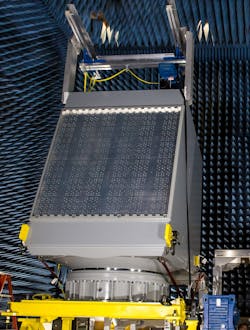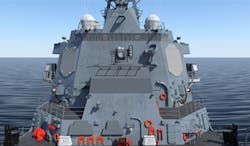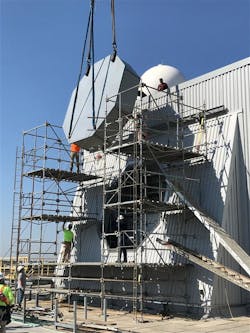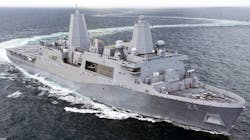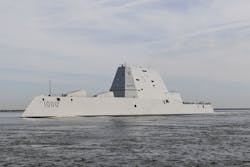U.S. Navy ships out on future force and digital transformation
NASHUA, N.H. - Facing continued budget austerity and new operational demands, the Navy in 2021 pushed forward on construction of new Flight III Arleigh Burke-class (DDG-51) destroyers, awarded a contract for engineering support for design of a new frigate class, and created a transformational strategy for building and upgrading ship combat systems. New destroyers and littoral combat ships (LCSs) joined the fleet, even while the Navy started decommissioning relatively new LCSs.
Last June Acting Navy Secretary Thomas Harker faced tough questions from the Senate Armed Services Committee about the Navy’s plans for building forceHarker said maintenance costs have growth 2.5 percent above inflation; personnel costs also are increasing above the inflation rate. As a result the Navy has delayed some ship buys to future years and divested less-capable assets.
The acting SECNAV stressed that “effective use and management of data is key to our digital transformation and will change how we fight and win at every level.”
Chief of Naval Operations Adm. Michael Gilday told the SASC that five years of analysis shows that “America needs a larger, more capable fleet.” He pointed out that in 2010 the Navy had 288 ships, today it has 296. He said that “if the Navy’s top line remains flat or if it goes down, the size of the fleet will definitely shrink.”
Gilday warned that “the Chinese battle force is the largest in the world,” now commanding a modern fleet of surface combatants, submarines, aircraft carriers, amphibious ships, and next-generation fighters.
China’s naval strength now is critical to mapping Navy acquisition plans. The Pentagon report, “Military and Security Developments Involving the People’s Republic of China,” released in November 2021, found that the PRC is developing capabilities for joint long-range precision strikes across domains, increasingly sophisticated space, counter-space, and cyber capabilities, speeding up expansion of its nuclear forces.
In August China conducted two tests of a hypersonic weapon system, including launching a missile potentially capable of carrying a nuclear warhead. Joint Chiefs of Staff Chairman Gen. Mark Milley called the tests “very significant, and very concerning.” Hypersonic missiles may travel at Mach 5, five times the speed of sound. In October Raytheon Technologies chairman Gregory Hayes said the U.S. is “several years behind” China in developing hypersonic weapons.
The DoD report said that the People’s Liberation Army Navy (PLAN) now has 355 ships and submarines, including more than 145 major surface combatants. The report says the PLAN soon will be capable of long-range strikes against land targets from surface ships and submarines.
The Navy also is watching Russian naval strength. The Defense Intelligence Agency has reported that the Russia’s navy has been improving its preparedness and building new surface ships and subs. DIA said the Russian navy now has about 32 major ships, including an aircraft carrier, three cruisers, 12 destroyers, and 11 frigates, along with 70 submarines.
The agency notes that while most of the Russian ships are between 20 to 25 years old, even older ships can launch the navy’s 3M14 Kalibr cruise missile thereby “increasing its ability to deliver precision strikes.”
According to Missiles of the World, the 3M14 Kalibr is a land-attack cruise missile able to carry a nearly 1,000-pound payload more than 1,500 miles. In late November the Russian frigate Admiral Gorshkov fired a Zircon hypersonic missile in the White Sea some 400 kilometers at a seaborne target.
Shipbuilding
In June 2021 the Navy announced a new shipbuilding plan. The Congressional Research Service, in its December background and issues analysis on Navy force structure, reported that the new plan modifies the 2016 total force structure target from 355 ships to 321 to 372 manned ships, augmented by 77 to 140 large unmanned vehicles.
The Navy says also that the future fleet “architecture” will have fewer large aircraft carriers, amphibious ships, cruisers, and destroyers, and more small carriers, amphibs, frigates, and unmanned vessels. This “distributed” fleet will include new Constellation-class (FFG-62) frigates, a light amphibious warship, and a next-generation medium logistics ship.
The FY 2022 budget sought funding for eight ships: two Virginia-class attack subs, one Burke-class destroyer, the first Constellation-class frigate, one oiler, two towing/salvage/rescue ships, and one surveillance vessel. The Navy requested $18.8 billion for shipbuilding, increased from the $17.8 billion sought for FY 2021. The Navy sought $3 billion for the first Columbia-class ballistic missile submarine.
CRS notes that the 355-ship target was for manned ships only, even though the Navy has fielded a number of unmanned surface and unmanned undersea vehicles (USVs and UUVs). Because most of them deploy from ships, subs, or aircraft, they weren’t counted in the ship total. Current plans to build larger USVs and UUVs that could deploy independently could mean they are counted within the force structure.
The shipbuilding plan released a year ago projected procurement of Flight III Burke destroyers through FY 2025. The FY 2022 request sought $122 million for concept work on a future surface combatant, now called DDG(X). Last summer the Program Executive Office for Ships established a DDG(X) program office to explore a DDG(X) follow-on to the Burke class. The PEO said the Navy wants to buy the first DDG(X) in FY 2028.
In early December the House of Representative passed the FY 2022 defense authorization bill, adding five ships to the Navy’s request: two Burke destroyers, two Expeditionary Fast Transport ships, and one oiler. The bill also directs the Pentagon to report to Congress on progress developing and testing hypersonic missile defenses.
In a key step toward creating the new fleet, the Navy last August awarded a $38.1 million contract to Fincantieri Marinette Marine for engineering support for detail design and construction of Constellation. The company won the construction award in April 2020.
The Navy in December commissioned Burke-class destroyer Daniel Inouye (DDG-118), built by General Dynamics Bath Iron Works. In October Bath christened Carl M. Levin (DDG-120).
The BIW yard also is building three Flight III ships, Louis H. Wilson Jr., William Charette, and Quentin Walsh (DDGs-126, – 130, and – 132). Huntington IngallsIn September the third and last Zumwalt-class destroyer, Lyndon B. Johnson (DDG-1002), completed sea trials at Bath. The ship then transited to Huntington Ingalls for combat systems and weapons integration. The first two ships, Zumwalt and Michael Monsoor (DDGs-1000 and – 1001) have been delivered.
In October Huntington Ingalls conducted builder’s trials for San Antonio-class amphib Fort Lauderdale (LPD-28). The LPDs will transport 650 Marines, who can be deployed by helicopters, MV-22 tiltrotor aircraft, or by air-cushion vehicles. Fort Lauderdale and Richard S. McCool (LPD 29) are transition ships to Flight II of the class, which begins with Harrisburg (LPD-30), now also in production. The Navy wants 13 Flight II ships.
In November the company received $113.6 million in additional advance procurement funds for America-class amphibious assault ship LHA-9. The Navy plans a construction contract for the ship in 2024.
Huntington has delivered America and Tripoli (LHAs-6 and – 7), called Flight 0, which were designed primarily for aviation operations and do not have a well deck for launching landing craft. Because of Marine Corps concerns, Bougainville (LHA-8), now under construction, and later LHAs will have welldecks.
The Flight 0 ships are built with a hybrid propulsion plant that uses twin electric motors for low speeds then switches to the General Electric LM2500+ gas turbine for higher speeds.
In October the Navy christened the LCS Santa Barbara (LCS-32). The ship is the 16th of the Independence variants, which are built to a “trimaran” hull design. Freedom variants are built with conventional hulls by Fincantieri Marinette Marine. The Navy christened Freedom-variant Nantucket (LCS-27) in August.
Through 2021 the Navy dealt with stubborn problems with the gear system on the Freedom variants. Last January the Navy advised systems integrator Lockheed Martin that it would not accept delivery of ships until flaws in the combining gear, built by a German company, RENK AG, have been repaired. The gear links the diesel and gas turbine engines to enable the ship’s 40-knot speed. Thirteen of the Freedom variants require the gear repair.
Although the lead ship, Freedom and Fort Worth (LCS-3) were built with a different gearing system, the Navy decommissioned Freedom in September after 13 years of a planned 25-year service life. The Navy plans to decommission three more Freedom ships and Independence variant Coronado (LCS-4). Independence (LCS-2) was decommissioned in last July.
Hypersonics, Advanced Weapons
China’s hypersonic missile tests last summer added urgency to Navy efforts to develop a conventional hypersonic weapon. The Navy requested $1.1 billion for FY 2022 for collaborative work with the Army on hypersonics. The Navy’s Strategic Systems Program Office, which is managing the CPS program, says the program seeks to “design, build, and sustain an evolving multi-service hypersonic capability.”
SSP says the Navy system is a hypersonic glide body that travels to its target at hypersonic speed and a booster that launches the glide body into initial flight. Both the Navy and Army would deploy the weapon and launch system in service-specific configurations. The services would use a common all-up round that could be launched from ships, submarines, and ground sites.
In an October SSP test, a Lockheed Martin-Northrop Grumman team successfully fired a first stage solid-rocket motor of a hypersonic strike system as part of the Navy’s CPS and the Army’s Long-Range Hypersonic Weapon initiatives. The test followed earlier tests in May and August. Lockheed is the team systems integrator and Northrop Grumman developed the motor used in the test.
SSP director Vice Adm. Johnny R. Wolfe Jr. said after the test that ‘’today’s successful test brings us one step closer to the design validation of our new hypersonic missile.”
Raytheon Technologies is teamed with Northrop Grumman on an Air Force/DARPA Hypersonic Air-breathing Weapon Concept, integrating a Raytheon hypersonic air-breathing missile with Northrop Grumman scramjet combustors. Last September the team conducted a successful flight test in which the missile, fitted with the scramjet motor, was released from an aircraft. The motor then ignited and propelled the missile to hypersonic speed.
The Naval Surface Warfare Center (NSWC) Dahlgren Division has pursued extensive research on hypersonic weapons technologies. Officials say that in the earlyThe Navy also is pursuing lasers, railguns and hypervelocity deck guns, which require far greater levels of power than conventional weapons. Lockheed Martin’s 60-kilowatt HELIOS (high-energy laser and integrated optical dazzler and surveillance unit) was scheduled to be installed on a Burke destroyer late last year.
The company won a $150 million contract in January 2018 for one HELIOS system for a ship installation and a second for land-based testing with options for 14 more.
Joe Ottaviano, a Lockheed Martin business development director, said that a laser system amounts to an “endless magazine that never runs out of power.” The company developed the HELIOS for Increment 1 of the Surface Navy Laser Weapon System (SNLWS) program, aimed at a 60-KW system that potentially could be increased to 150 KW.
Navy officials say the system could be used to counter UAVs, small craft, and hostile sensors, and for combat identification and battle damage assessment.
The effort is part of the Navy’s Laser Family of Systems program, which includes a solid-state laser technology maturation initiative of the Office of Naval Research and an optical dazzling interdictor called ODIN. ONR also funded work on a 30-kilowatt laser weapon system (LaWS) demonstrator and Mk 38 tactical laser system. Raytheon, Northrop Grumman, and BAE Systems developed concepts for a 100-150 KW prototype LaWS.
A critical challenge has been generating adequate ship power. In March 2021 the NSWC Dahlgren and Philadelphia divisions started collaborating on an initiative called PEGASUS (Power and Energy Generation Analysis Simulation System) to integrate high-powered electric weapons and shipboard electric propulsion systems.
Team Leader Thomas McKelvey said the team demonstrated the integration of a ship combat system with ship machinery, aiming at coupling high-energy weapons with power systems. He said the team used a 50-KW laser to measure voltage and thermal characteristic data and developed lessons for testing a 300-KW High Energy Laser Counter Anti-ship Cruise Missile Project (HELCAP) test bed. NSWC officials say the testbed is used to demonstrate laser technologies to defeat anti-ship cruise missiles.
Ship Systems, Weapons
The Navy in 2021 moved to transform its processes for development and upgrade of ship combat systems, the computer hardware and software architectures that control sensors, process received sensor data, and launch weapons. The Aegis system aboard Ticonderoga cruisers and Burke destroyers has evolved over years through “baselines” to provide new capabilities. Baseline development has been an onerous, expensive process of software code-writing, troubleshooting, and testing.
In March 2021 the Program Executive Office for Integrated Warfare Systems (PEO IWS) set up a “software factory ecosystem” named the Forge in Riverdale, Md., modeled after the Air Force’s Kessel Run facility near Boston. The Forge acts as nerve center for streamlining software development in order to move new combat systems software rapidly to ships.
Industry has jumped in. Northrop Grumman has supported the Air Force’s digital transformation initiatives. Jim Sheridan, until recently manager of Lockheed Martin’s Moorestown, N.J., site, says that digital transformation aims to shatter the paradigm of taking years to introduce upgrades and to get them to ships in as little as 24 hours.
In September Lockheed Martin demonstrated a Virtual Aegis Weapon System (VAWS) during the Indo-Pacific Command’s Valiant Shield exercise. The VAWS provided targeting data for Army and Air Force operations centers to demonstrate weapons launches.
The company also demonstrated the VAWS in the Air Force’s Northern Eagle exercise in Alaska last May and in the Australian-run Talisman Shield in June through August.
Sheridan says that Aegis “virtualization” allows the system to be distributed in multiple nodes and used in air, land, and naval domains, without the need for an Aegis-equipped ship.
The company has teamed with SOLUTE to improve cybersecurity for Aegis software and formed a partnership with Innovative Defense Technologies to create an “Aegis Enterprise Platform as a Service” to use digital technologies to deliver updates to test sites. The company also is using Amazon Web Services cloud technology for data-engineering tasks.
The Navy moved critical new ship systems toward deployment and upgraded fielded systems. The SPY-6(v) air and missile defense radar (AMDR), built by Raytheon, was installed aboard Flight III Burke DDG Jack H. Lucas at Huntington Ingalls shipyard prior to the ship’s June launch. SPY-6(v) variants also will be go aboard America-class amphibs, Nimitz – and Ford-class carriers, Constellation frigates, and Flight IIA Burkes. In December Raytheon won contracts worth about $290 million for additional work on AMDR.
Although Raytheon won the SPY-6(v) contract, ousting Lockheed Martin from its long-held position as the builder of the SPY-1(v) radar for the Burke class, Lockheed will provide the Aegis combat system for the new radar. Both companies are working on integrating the Aegis Baseline 10 program with the radar.
Lockheed Martin also is the combat systems integrator for the new Constellation class, using Aegis Baseline 20, and for the ship self-defense system aboard Wasp – and San Antonio-class amphibs.
The Missile Defense Agency is funding Lockheed for work on the ballistic missile defense computer program called Baseline 5.4. The company is developing a low-noise amplifier, along with a digital LNA that will enable future software upgrades to the SPY radars aboard in-service Burkes.
Lockheed Martin also is building its new SPY-7 Aegis radar for Spain’s F-110 frigate program and Canada’s new Surface Combatant. The MDA’s Aegis Ashore sites in Romania and Poland also will get the SPY-7. The Aegis system in Deveselu, Romania site is operational; the site in Redzikowo, Poland is expected to be operational by late 2022. Control then will transition to NATO.
Between September and December Raytheon won more nearly $330 million in contracts for engineering services and baseline support for the USG-2/3 Cooperative Engagement Concept (CEC), the latest in a long series of awards for CEC support.
The Navy started fielding CEC in late 2001. It consists of a CEC processor, data-distribution system or DDS, and a directional active-array antenna. The system creates a comprehensive sensor network that allows CEC-equipped ships and aircraft to share target-track data. In October DRS Laurel Technologies received a $12.3 million award for CEC components. In July DRS won a $28 million award for consoles, displays, and peripherals for future surface ship combat systems.
Also in October Raytheon’s Missiles and Defense unit won $30 million for two contracts for upgrades for the Tomahawk ship – and sub-launched cruise missile. The Navy is recertifying its inventory of 15-year-old Block IV missiles to a new Block V configuration by adding communications and navigation upgrades. The company has started delivering Block V missiles.
The October awards fund Raytheon for development of a Block Va variant, called the Maritime Strike Tomahawk (MST), which will be fitted with a multimode seeker to enable it to hit moving seaborne targets. A Block Vb Tomahawk will receive a Joint Multiple Effects Warhead system or JMEWS, capable of attacking additional land targets. Navy Tomahawk program manager Capt. John Red says the MST will start fielding in 2024 and JMEWS in 2027.
The Navy is looking to augment ship torpedo-defense with a new very lightweight torpedo (VLWT), based on longtime work by Penn State’s Applied Research Laboratory. A Penn State design for a Compact Rapid Attack Weapon (CRAW) was shown to industry in 2016.
Northrop Grumman Naval and Oceanic Systems has designed a VLWT torpedo only 171mm or 6.75 inches in diameter. The weapon will be capable of attacking submarines but also of rapidly identifying, classifying, and engaging approaching torpedoes.
The Penn State CRAW work was funded by ONR for many years. The Navy plans to select a contractor to develop a design for rapid manufacture.
Ship Power Systems
The Navy made modest progress in transitioning surface ships from conventional power systems to integrated electric power. PEO Ships, in setting up the DD(X)In June 2020 NAVSEA published a Naval Power and Energy Systems Technology Development Roadmap that proposed strategies for expanding ship power capacity to support the power-hungry SPY-6(v) radar, rail guns, and lasers. The hybrid systems aboard America-class amphibs and the modified IPS aboard Zumwalt destroyers are key steps to the all-electric power architectures defined in the 2020 Roadmap. The Navy also wants to shift to an IPS for the Columbia-class ballistic missile sub.
In September the NSWC Philadelphia lab awarded DRS Naval Power Systems a $57 million contract for upgrades to switchboard circuit breakers aboard the LSD, LCC, LPD, and LHD amphib classes. The Philly lab also awarded $15 million to Rolls-Royce Solutions America for modernization and in-service support for MTU engines and shipboard auxiliary systems. In June NAVSEA awarded $77 million to Timken Gears & Services for main reduction gear shipsets for Flight III Burke destroyers Richard G. Lugar and John F. Lehman (DDGs-136 and – 137).
The Raytheon SPY-6(v) air and missile defense radar (AMDR) was installed aboard Flight III Burke-class destroyer USS Jack H. Lucas at Huntington Ingalls shipyard prior to the ship’s June launch.

